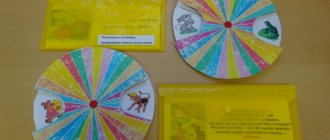MAGAZINE Preschooler.RF
Moral education of children in play activitiesIlchenko Ekaterina Valerievna MBDOU "DS N 336, Chelyabinsk" Educator
The moral education of children is one of the most difficult tasks of education in a preschool educational institution. Johann Herbert wrote: “The single task of education can be entirely expressed in one word - morality” [9, p. 102] Since the basis of educational activity is the process of transforming moral norms into the internal beliefs of the individual, the educator is a “co-author” and “supplier” of the influence of society on the individual.
K.D. Ushinsky said that the education of morality is the main task of education, much more important than the development of the mind. [18, p.63] In the dictionary of S.I. Ozhegova “morality is the internal, spiritual qualities that guide a person, ethical standards, rules of behavior determined by these qualities” [13, p.420]
According to the definition of V.A. Sukhomlinsky, the essence of the process of moral education is that “moral ideas become the property of every child and turn into norms and rules of behavior” [17, p.114] From this statement we can conclude that only by mastering the norms and rules of moral behavior, a child will be morally educated and this will become a part of his life. I.S. Maryenko believed that “morality is an integral aspect of the personality, ensuring its voluntary compliance with the relevant norms, rules, principles of behavior; they are expressed in relation to the Motherland, society, team, individuals, to oneself, work, etc. » [ 12, p.7 ] It was L.S. Vygodsky pointed out the importance of the moral development of children, emphasizing that the beginning of this age period is associated with the emergence of a generalization of experiences and the logic of feelings. For the first time, the child begins to understand what it means “I am happy,” “I am sad,” “I am angry,” “I am kind,” “I am evil,” and he has a meaningful orientation in his own experiences. [5, p. 10]
“The younger the child, the more direct his moral education should be, the more he should not be taught, but accustom him to good feelings, inclinations and manners, basing everything mainly on habit,” emphasized V.G. Belinsky. [13, p. 212]
L.I. Bozhovich defined the moral qualities of an individual as “relatively stable psychological characteristics, manifested in various types of behavior and activities of the child, in his attitude towards the environment and himself” [3, p. 104 ]
In the works of N.A. Vetlugina and I.F. Svadkovsky identifies the main directions of moral education of preschoolers in a kindergarten:
- “development of moral experience in collective life, in communication, in joint activities” [4, p. 8 ]
- “formation in the child of moral needs in communication, in work, in the development of cultural values, etc.” [ 15, p. 41 ]
- Include the preschooler in “situations that require the child’s participation, empathy and enrich the child’s feelings with moral content” [4, p.12]
- “Subordination to the motives of behavior, focused on the development in the child of a conscious ability to be guided in his behavior by moral motives, which leads to the formation of the foundations of the moral orientation of the individual” [4, p. 12 ]
The Law “On Education in the Russian Federation” defines education as “purposeful activity aimed at creating conditions for the development of spiritual and moral culture based on universal human values.” [ 8 ]
The Federal State Educational Standard for Preschool Education identifies the following tasks:
- » combining training and education into a holistic educational process based on spiritual, moral and sociocultural values and socially accepted rules and norms of behavior in the interests of the individual, family, and society
- “formation of a general culture of children’s personality, including the values of a healthy lifestyle, the development of their social, moral, aesthetic, intellectual, physical qualities, initiative, independence and responsibility of the child, the formation of prerequisites for educational activities.” [19, paragraph 5]
Thus, the formation of any moral quality must take place consciously. The child needs knowledge on the basis of which he will develop concepts about the essence of moral quality and its necessity.
Moral education is carried out using certain means and methods.
“The choice of means of education depends on the leading task, on the age of the children, on the level of their general and intellectual development, on the stage of development of moral qualities (we are just beginning to form a quality, or we are consolidating it, or we are already re-educating.)
The remedy becomes effective in combination with adequate methods and techniques of education.” [ 11, p. 45]
Based on work practice, we can say with confidence that one of the means of moral education of preschoolers is play. Gaming activities form in preschoolers:
- voluntary behavior;
- creative imagination;
- self-awareness;
- interpersonal relationships;
- communication skills.
In the game, children master collective planning skills, learn to fairly resolve disputes, and coordinate their actions. All this contributes to the accumulation of moral experience.
What is a game? Is it possible to define a game?
“It is difficult,” as K. Gross emphasizes, “if we demand a strictly scientific definition, expressed in completely clear psychological terms. It is relatively easy if we are content with contrasting the concept of play and its opposite - work or serious activity." [6]
It was K. Gross who first substantiated the now generally accepted idea that play largely determines the content and originality of childhood.
In the beginning there was a game, not a word, if we talk about the beginning of the culture of all humanity or the beginning of a child’s entry into the life. While playing, the child almost unconsciously masters the shapes and sizes of things and objects, their location in space, distinguishes colors and sounds, learns the first words - signals, reacts, observes, remembers, and expands his horizons. To understand the nature of play, its amazing educational and developmental potential is to understand the nature of a happy childhood. Game is the most powerful sphere of “selfhood”: self-expression, self-determination, self-testing, self-rehabilitation, self-realization. [7, p. 4]
You can also highlight four main features inherent in the game:
- free developmental activity undertaken only according to the child’s wishes, for the sake of pleasure from the process of activity itself, and not just from the result (procedural pleasure)
- creative, largely imitative, very active nature of this activity (“field of creativity”)
- emotional elation of activity, rivalry, competitiveness, competition, attraction, etc. (sensual nature of the game, "emotional tension")
- the presence of direct or indirect rules reflecting the content of the game, the logical and temporal sequence of its development" [1, p. 9]
Z.M. Boguslavskaya notes that any game contains two types of rules - rules of action and rules of communication with partners.
Rules of action determine methods of action with objects, the general nature of movements in space (pace, sequence, etc.).
The rules of communication influence the nature of the relationship between the participants in the game (the order in which the most attractive roles are performed, the sequence of children’s actions, their consistency, etc.). So, in some games, all children act simultaneously and in the same way, which brings them closer, unites them, and teaches them good-willed partnership. In other games, children take turns, in small groups. This gives the child the opportunity to observe peers and compare their skills with their own. And finally, each section contains games in which a responsible, attractive role is played in turn. This contributes to the formation of courage, responsibility, teaches you to empathize with your playing partner and rejoice in his successes.
These two rules, in a simple and accessible form for children, without edification or imposing a role on the part of an adult, teach children to be organized, responsible, self-restraint, and develop the ability to empathize and be attentive to others. [ 2, p. 6]
N.K. Krupskaya said: “It is very important not to stereotype games, but to give scope to children’s initiative. It is important that children come up with games themselves, set goals for themselves... The teacher should not hamper the initiative of the children, discourage them, impose certain games... [10, p. 345]
Practice shows that with the help of a teacher, children undergo vital socialization in a playful way and develop the abilities and skills to live and develop in modern society. It is very important to emphasize that all matters related to the conduct of a particular game should be aimed not at the successful conduct of the game, but at the full participation of everyone in the implementation of the game.
Children themselves offer or choose the form and degree of their participation in the game. The child develops through play. The game develops the child’s communication style with peers and adults, and develops moral feelings. At the same time, it is possible to instill morality in a child not only by the staff of the preschool educational institution, but also by the parents.
Children play in large groups in a coordinated manner, but everyone wants to play an interesting role. The teacher needs to reveal to the children the new content of the game. For example, looking at buildings located next to a kindergarten, drawing buildings, taking a targeted walk to an existing construction site. At the same time, he plays along with the children, without linking his actions with a specific role, but occasionally enters into communication in turn with all the children who need to be influenced at one time or another during the game. The educational influence of the game is enhanced.
Having taken on some role (doctor, pilot, driver...), the child does not just try on the profession and characteristics of someone else’s personality: he enters into it, gets used to it, penetrating into her feelings and moods, thereby enriching and deepening his own personality. But not in every game, the acquisition of a child has a positive meaning. Let's say the boys are playing family: Alexander portrays a caring father, Oleg imperiously commands the children, shouts at his wife. Comparing the feelings experienced in these games, it becomes clear that they will have different effects on the formation of character and attitude towards the world around us. Girls, playing the role of “mother,” also imitate their mothers. But in “family” games, concern for grandparents, older and younger children is very rarely shown. All these facts indicate that families lack targeted pedagogical guidance for moral education in the everyday lives of children.
“Whether play will become an effective means of moral education largely depends on the parents: on what kind of games are encouraged by the father and mother; what toys are bought, how holidays and entertainment are held in the family, etc.”[ 16, p. 85]
The content and rules of the game are the basis for developing the moral qualities of a child’s personality. Games such as: “Finish the story”, “Do not say yes and no”, “Secret word”, “Four elements”, “Scouts”, “Bad and good”, “Game of fire and extinguishing it”, “Road traffic” in the city”, “Excursion to the taiga”, “Our country”, “Life in the forest”, “Where will the dolls go today?”, “Situation games”, “Help grandma”, “Good and evil”, “Secret friend” pursue the following goals:
- encourage your child to make friends
- teach children to work in a team
- help your child talk about himself
- focus children's attention on the good qualities of a person
- to form feelings of respect for people, to introduce ethical standards of behavior
- to cultivate friendliness, mutual assistance, goodwill, and respectful attitude towards peers.
Gradually, children learn moral standards through play, and responsibility for performing actions increases.
Psychologist D.B. Elkonin identified three stages of this process:
- the child is focused on learning the properties and qualities of objects and the possibility of acting with them. Having satisfied his interest in objects, the child begins to show attention to the actions of other children playing nearby. Thus, at this stage the foundation is laid for the further development of children's relationships.
- Children's interest moves to the sphere of relationships between adults. The teacher, leading the game, aims children at mastering moral norms that serve as the basis for humane human relations
- The child subordinates objective actions, even the most attractive ones, to the main play goal determined by the play role. The other person becomes the center of attention. Game actions are performed in the situation of using their results for the benefit of other people, that is, the activities of preschoolers acquire a social orientation. The main way to enrich the game with moral content is through familiarizing children with the phenomena of social life and cultivating positive attitudes towards them. [20, p. 205]
In a playful relationship, the child voluntarily exercises and masters normative behavior. The game requires its participants to be able to act according to the rules.
“What a child is like at play, so in many ways he will be at work when he grows up,” said A.S. Makarenko.
» While playing, the child masters important social skills. The roles and rules of the "children's society" allow you to learn about the rules accepted in adult society. The game develops feelings of cooperation and competition. And concepts such as prejudice, equality, leadership, submission, devotion, betrayal, begin to take on real personal meaning.” [14, p. 15]
Moral education in play is a complex process that a child goes through from 3 to 7 years old. During this time, the preschool child acquires new social experiences that carry over into life. It is through play that the level of moral development of preschoolers increases and basic moral norms are formed.
Literature
- Azarov Yu.P. The art of education: a book for teachers. M.: Education, 1985.
- Boguslavskaya Z.M., Smirnova E.O. Educational games for children of primary preschool age. M.: Education, 1991.
- Bozhovich L.I. Studying the personality qualities and effective sphere of the child. M.: Publishing House of the Academy of Pedagogical Sciences of the USSR, 1963. Issue. 5
- Vetlugina N.A. Moral and aesthetic education of a child in kindergarten. M.: Iris-Press, 2011
- Vygodsky L.S. Educational psychology / ed. V.V. Davydova. — M.: AST: Astrel: Guardian. 2008
- Gross K. The mental life of a child. — Kyiv, 1916
- Dybina O. Game is the path to knowledge of the objective world. //Preschool education. 2004-N5
- Law "On Education in the Russian Federation" dated July 10, 1992. N3266-1 (as amended on December 29, 2013 N 273)
- Kozlova S.A., Kulikova T.A. Preschool pedagogy. M.: Academy
- Krupskaya N.K. Ped. op. M.:, 1959, T.6
- Kudryavtseva E., Ledovskikh N.O. On the moral education of children of different sexes in a peer group // Preschool education. — 2003. -N 9
- Maryenko I.S. Moral development of a schoolchild's personality. -M.: "Pedagogy", 1985
- Ozhegov S.I. Dictionary of the Russian language. - M.: OOO Publishing House "World and Education", 2008
- Petrunek V.P., Taran L.N. Junior preschooler. - M.: Pedagogy, 1994
- Svadkovsky I.F. Moral education. - M.: Academy, 2011
- Solntseva O. “We play story games.” // Preschool education. - 2005. - N 1
- Sukhomlinsky V.A. I give my heart to children. - M.: Academy, 2014
- Ushinsky K.D. Favorites. -M.: Vlados, 2009
- Federal state educational standard for preschool education, approved by order of the Ministry of Education and Science dated October 17, 2013. N1155
- Elkonin D.B. Psychology of playing - Minsk. — Light, 1998
| Next > |
Progress of the game:
Dad is upset because...
Mom was upset about...
Grandfather looked at me sternly because...
The younger brother burst into tears because.
And so on.
The conclusion of such a game could be the following questions:
— What needs to be done to improve the mood of a loved one?
—Have you ever been attentive to the mood and well-being of your relatives?
"Life in the Forest"
Goal: the formation of friendly relationships, sympathy for others, attracting attention to the partner: his appearance, mood, actions, deeds.
Progress of the game: teacher (sits on the carpet, seating children around him)
.
“Imagine being in a forest and speaking different languages. But you need to communicate with each other somehow. How to do it? How to ask about something, how to express your friendly attitude without saying a word?
To ask a question, how are you, clap your palm on your friend’s palm (demonstration)
.
To answer that everything is fine, we tilt our head to his shoulder; we want to express friendship and love - we affectionately stroke the head (show)
.
“It’s early morning, the sun is out, you just woke up.”
.
The teacher unfolds the further course of the game at random, making sure that the children do not talk to each other. Communication without words eliminates quarrels, disputes, contracts, etc.
"Good Elves"
Goal: formation of friendly relationships, empathy for others.
Opinions of teachers from the past about the role of play in raising a child
The importance of play in raising a child is considered in many pedagogical systems of the past and present. Most teachers regard play as a serious and necessary activity for a child.
In the history of foreign and Russian pedagogical science, two directions have emerged in the use of games in raising children:
1) for comprehensive harmonious development
2) for narrow didactic purposes.
A prominent representative of the first direction was the famous Czech democratic teacher Jan Amos Comenius (1592-1670). He considered play an important form of a child’s work, corresponding to his nature and predispositions: play is a serious mental work of a child, in which all types of the child’s capabilities develop, the range of ideas about the world around him expands and is enriched, and speech develops; In common games, the child gets closer to his peers. Considering play as a condition for “cheerful youth and as” a means of multifaceted, harmonious development of a child, Ya. A. Komensky recommended that adults treat children’s games carefully and manage them wisely.
The didactic direction of using the game developed in the 18th century. from teachers-philanthropists (I.B. Bazedov, Kh.G. Zaltsman, etc.). The didactic direction is most fully represented in the pedagogy of F. Froebel. Froebel's views on the game reflected the religious and mystical foundations of his pedagogical theory. The process of play, argued F. Frebel, is the identification and manifestation of what was originally inherent in a person by the deity. Through play, a child, according to Froebel, learns the divine principle, the laws of the universe and himself. Froebel attaches great educational importance to the game: the game develops the child physically, enriches his speech, thinking, and imagination: play is the most typical activity for preschoolers. Therefore, Froebel considered play to be the basis of education. He has developed various games for children (active, didactic), among them games “with gifts”. Froebel attached special importance to these games.
In children's institutions working according to the system of M. Montessori or F. Froebel, the main place is still given to didactic games and exercises with various materials; Children’s independent creative games are not given value.
Important thoughts about the role of play in the formation of a child are contained in the works of K.D. Ushinsky, P.F. Kaptereva, P.F. Lesgafta and others.
K.D. Ushinsky pointed out the dependence of the content of children's games on the social environment. He argued that games do not occur without any traces for a child: they have every chance of determining the character and behavior of a person in society. Thus, “a child who is accustomed to commanding or obeying in a game does not simply unlearn this orientation in real life.” K.D. Ushinsky attached great importance to collective games, since the first social relationships are established in them. He valued children’s independence in play and saw this as the basis for the deep influence of play on a child, but he considered it necessary to guide children’s play, ensuring the moral content of children’s impressions.
A significant contribution to the study of play pedagogy was made by P.F. Lesgaft (1837-1909). He viewed play as an exercise through which a child prepares for life. In his pedagogical system P.F. Lesgaft paid main attention to the physical education of children. He developed a system of outdoor games in which the physical and spiritual strength of the child develops.
E.I. Tikheyeva considers play as one of the forms of organizing the pedagogical process in kindergarten and, at the same time, as one of the most important means of educational influence on the child. The forms of the game and its content are determined by the environment in which the child lives, the environment in which the game takes place, and the importance of the teacher who organizes everyday life and helps the child navigate it.
She attached great importance to outdoor games, which she considered the most important form of physical exercise. In her opinion, outdoor games discipline, develop a sense of responsibility and teamwork, but they must be carefully selected in accordance with the age capabilities of the children.
A special award goes to E.I. Tikheeva in revealing the role of didactic games. She correctly believed that didactic play highlights the possibility of developing the child’s various abilities, his perception, speech, and attention. She outlined the special role of the teacher in the didactic game: he introduces children to the game, introduces it to its content and rules. E.I. Tikheyeva came up with a large number of didactic games that are still used in children's institutions.





